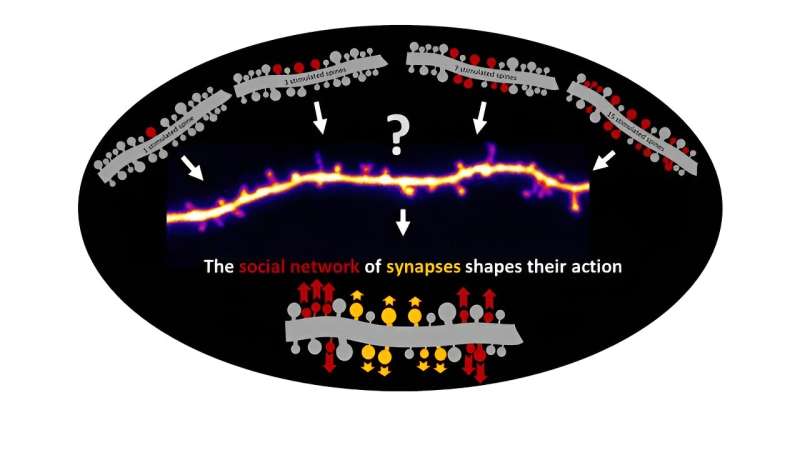This article has been reviewed according to Science X's editorial process and policies. Editors have highlighted the following attributes while ensuring the content's credibility:
fact-checked
peer-reviewed publication
trusted source
proofread
Study reveals how neighboring synapses coordinate their response to plasticity signals

Researchers from Bonn and Japan have clarified how neighboring synapses coordinate their response to plasticity signals: Nerve cells in the brain receive thousands of synaptic signals via their "antenna," the so-called dendritic branch. Permanent changes in synaptic strength correlate with changes in the size of dendritic spines. However, it was previously unclear how the neurons implement these changes in strength across several synapses that are close to each other and active at the same time.
The researchers—from the University Hospital Bonn (UKB), the University of Bonn, the Okinawa Institute of Science and Technology Graduate University (OIST) and the RIKEN Center for Brain Science (CBS)—assume that the competition between spines for molecular resources and the spatial distance between simultaneously stimulated spines affect their resulting dynamics. The results of the study have now been published in the journal Nature Communications.
Neurons are the computing units of the brain. They receive thousands of synaptic signals via their dendrites, with individual synapses undergoing activity-dependent plasticity. This synaptic plasticity is the mechanism underlying our memory and thinking and reflects long-lasting changes in synaptic strength.
When learning new memories, particularly active synapses strengthen their connections in a process known as "long-term potentiation" (LTP). However, how neurons allocate resources to translate synaptic strength changes through space and time among neighboring synapses has been unclear. Until now, it was assumed that each synapse decides independently of the others how it changes
The study suggests a new perspective on how neighboring synapses coordinate their response to plasticity signals. Researchers from Bonn and Japan have found that the sharing of proteins and calcium makes synaptic plasticity a collective action in which the behavior of one synapse influences how the others can respond.
"When several synapses want to potentiate at the same time and are close to each other, they compete with each other so that each synapse potentiates less than if it were alone. On the other hand, the simultaneous potentiation of a few synapses can facilitate the plasticity of other synapses through the overflow of activated resources," says Prof. Tatjana Tchumatchenko, from the Institute for Experimental Epileptology and Cognition Research at the UKB and member of the Transdisciplinary Research Area (TRA) "Modeling" at the University of Bonn. She led the study together with Prof. Yukiko Goda from the OIST in Japan.

Strong competition among neighboring spines
The researchers from Bonn and Japan used the release of glutamate, an important excitatory neurotransmitter in the brain, in conjunction with computer-assisted models to investigate the molecular processes of the plasticity of several spines. Spines, mushroom-shaped protrusions of nerve cells, are found in the brain and can strengthen synaptic connections.
"Glutamate release allows precise manipulation of selected synapses, which allowed us to observe exactly how many synapses potentiate and to what extent," explains Dr. Thomas Chater, who conducted the research at the RIKEN Center for Brain Science in Japan.
"This data allowed us to design a model and adjust its parameters to a set of three stimulated spinous processes, i.e. spines, to then predict how seven or fifteen spinous processes would behave," explains Dr. Maximilian Eggl, who until recently was a Postdoc at the University of Bonn and conducted research at the UKB. Chater and Eggl are both co-first authors of this study and worked closely together.
Study leaders Prof. Tchumatchenko and Prof. Goda were particularly surprised by the extent of competition among neighboring spinous processes, which was strongest in the first two to three minutes after plasticity was triggered and influenced the direction and extent of plasticity.
"Our results show that the spatial arrangement of simultaneously stimulated synapses significantly influences the dynamics of spine growth or shrinkage, suggesting that multiple memories stored on the same dendrite may influence each other," explains Prof. Goda.
The principal investigators are confident that understanding how neurons manage synaptic resources will contribute to a better understanding of cognitive processes in the healthy brain and thus to the development of new strategies to combat Alzheimer's disease, autism spectrum disorders and other cognitive impairments.
More information: Thomas E. Chater et al, Competitive processes shape multi-synapse plasticity along dendritic segments, Nature Communications (2024). DOI: 10.1038/s41467-024-51919-0



















